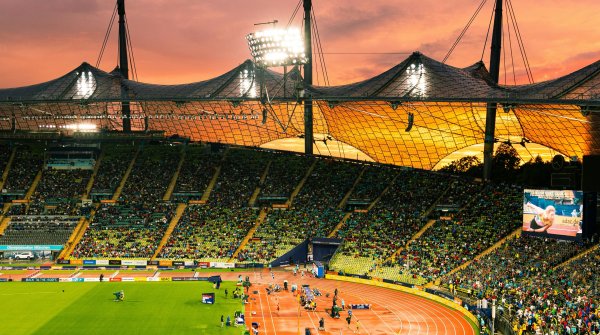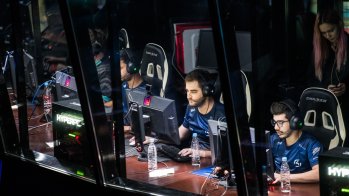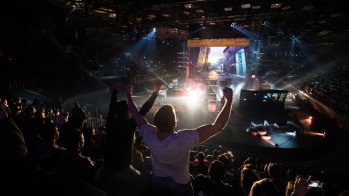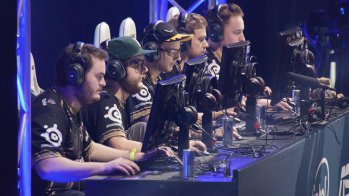
Whether Dota, League of Legends, or Blizzard's StarCraft, there's hardly a game in the eSports universe that doesn't feature one of South Korea's top teams. One of the reasons why eSports is so popular in this country is its media presence. In contrast to Germany, for example, where the public perception of eSports is still in its infancy, there are stations that specialize in reporting and organizing various eSports events. One of the best known: OnGameNet (short: OGN).
The station was founded in 2000 and now belongs to the CJ Group, a huge conglomerate that generates billions in revenues and whose entertainment division accounts for around 19% of the total. But OGN not only broadcasts various tournaments, but also hosts them itself, and has done so since 2000.
Sport of the future: eSports in pictures
At that time the station founded its own StarCraft league for single players with OSL (OnGameNet StarLeague) and in 2003 the so-called Pro League for multiplayer battles. In the same year the MSL, a foundation of the channel MBCGame, was founded as a competitor. Two years later, both broadcasters agreed to run only one joint team league. The driving force in the background was the Korean e-Sports Association (KeSPA). The beginning of a real success story: Already in 2005 more than 100,000 spectators watched the final of the merged Pro League at the Gwangalli beach.
In contrast to many other countries in which eSports leagues already existed in the past, KeSPA in Seoul established an organisation which, at the same time as the increasing professionalisation of sport by the above-mentioned television leagues, also created the corresponding framework conditions that encouraged this development.
Anyone who has followed the discussion on the subject of eSports in Germany in recent months is likely to be jealous of South Korea. While the German Olympic Sports Federation is reluctant to recognize e-gaming as a sport, the Korean eSports Association is already a member of the National Olympic Committee of South Korea.
In addition, with the founding of the organisation in February 2000, the same powerful donors were brought on board who provided sufficient funds for the financial structuring. At the same time, the professional gamer organization was also supported by the state.
Thus, the "Ministry of Culture, Sport and Tourism" officially gave the go-ahead to install the Korean eSports Association called "21C Programer Association". Thanks to the government's commitment, it was also possible for the South Korean Air Force to set up a professional team and send it to the ring in 2007.

Thanks to the powerful donors who supported KeSPA, it was already possible for the company to build the world's first pure eSports stadium in 2005. This was built in the Yongsan district and is still the Mecca for every eSports fan. Meanwhile there are some more arenas, for example the Nexon-Arena or the OGN E-sports Stadium. Here the pro-gamers enjoy a similar status to the pop stars or sportsmen we celebrate and are just as admired. The jerseys of the idols are sold millions of times, and the pro gamers are coveted advertising media.
Many of the South Korean pro teams have potent sponsors like SK Telecom, Samsung or Korea Telecom behind them who take care of everything. Often the teams live together in one house and are supported in every respect.
Just as with professional sports teams, cooks and nutritionists take care of the right food, coaches challenge and support the players wherever they can. In addition, each team has Game Observers that work with the team and coaches to develop possible strategies against other teams. The salaries of the players can also keep up with those of top athletes.

The young players are recruited from the so-called "PC-Bangs", of which there are estimated to be more than 20,000 in South Korea - these are most comparable to cyber cafés and open 24 hours a day. However, gamers here have the chance to play their favourite titles for hours with their friends and compete with others.
The success of eSports in South Korea is by no means monocausal, but is based on several pillars. Thus it was possible at an early stage to create professional structures at all levels and to make eSport accessible to a broad mass of people.
 Sports BusinessThe future of the bike industry: 6 innovative bike stores
Sports BusinessThe future of the bike industry: 6 innovative bike stores
- ISPO awards
- Mountain sports
- Bike
- Design
- Retail
- Fitness
- Health
- ISPO Job Market
- ISPO Munich
- ISPO Shanghai
- Running
- Brands
- Sustainability
- Olympia
- OutDoor
- Promotion
- Sports Business
- ISPO Textrends
- Triathlon
- Water sports
- Winter sports
- eSports
- SportsTech
- OutDoor by ISPO
- Heroes
- Transformation
- Sport Fashion
- Urban Culture
- Challenges of a CEO
- Trade fairs
- Sports
- Find the Balance
- Product reviews
- Newsletter Exclusive Area
- Magazine






















